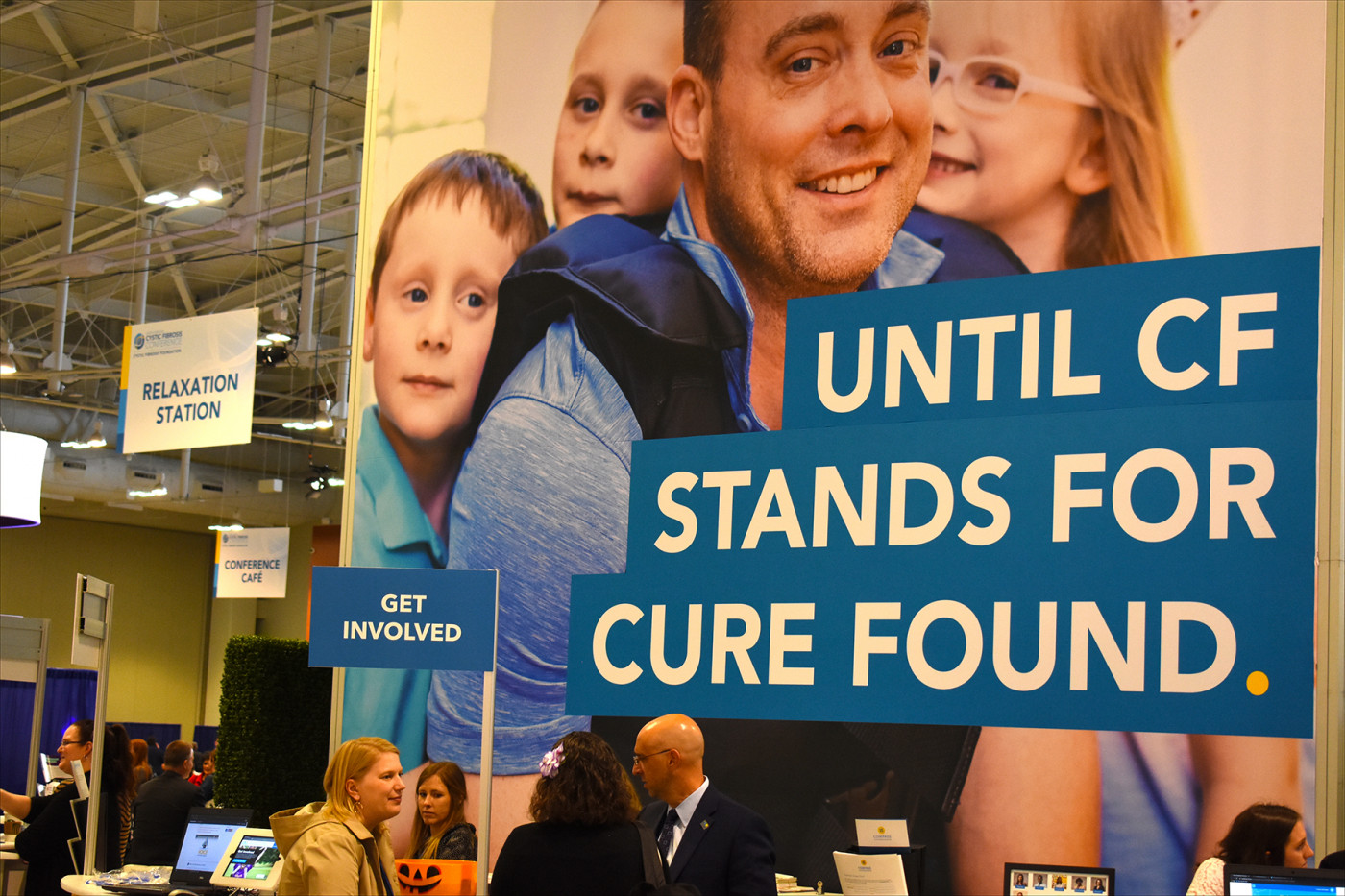CFF Strives to Improve Lung Transplant Journey for Cystic Fibrosis Patients

Cystic Fibrosis Foundation display at NACFC 2019 in Nashville urges a cure for CF. (Photo by Larry Luxner)
When it comes to lung transplants, the Cystic Fibrosis Foundation (CFF) admits that for a long time the issue was shrouded in confusion, frustration, and lack of information. But that’s changed substantially in recent years, says Albert Faro, MD, head of the nonprofit’s Advanced Lung Disease Initiative.
“In the past, cystic fibrosis patients expressed lots of concerns about the transplant journey,” Faro told Cystic Fibrosis News Today. “The referral process was very frustrating — with a great deal of variability among transplant programs — and people really didn’t know what to expect.”
In addition, he said, “the foundation heard loud and clear from people with cystic fibrosis that once they chose to pursue a transplant, they felt disenfranchised from the CF community.”
Responding to such concerns, the CFF launched its Advanced Lung Disease Initiative in 2015 and hired Faro — a pediatric pulmonologist at Washington University in St. Louis, Missouri — to run it. A key member of the team Faro assembled is Joseph Pilewski, MD, a transplant pulmonologist at the University of Pittsburgh and co-director of its Cystic Fibrosis Research Center.
In 2017, the annual North American Cystic Fibrosis Conference (NACFC) included, for the first time, a one-hour plenary on lung transplant that featured Pilewski.
“Working with Joe, we’ve mapped out a strategy — a very robust, multi-pronged, community-wide effort to eventually improve transplant outcomes,” Faro said in a phone interview from CFF headquarters in Bethesda, Maryland.
The CFF has so far committed about $24 million to lung transplant issues, and $3 million for palliative care and advanced lung disease. The initiative today employs four full-time CFF staffers, up from only Faro three years ago.
Extending life expectancy
On average, each year about 250 cystic fibrosis (CF) patients undergo lung transplants. These represent about 10% of the 2,530 lung transplants performed in U.S. hospitals last year, according to the United Network for Organ Sharing (UNOS).
In the clinical domain, 10 of the largest lung transplant and CF programs in the U.S. and Canada have joined CFF in a North American consortium aimed at improving outcomes.
“Over the last 20 years, our progress in lung transplantation has been limited, and a big reason for that has been that people worked in silos,” Faro said. “The transplant literature is littered with articles and studies that were single-centered, and the conclusion of all these articles was that their results need to be validated in a larger, multicenter trial. Our goal is to help facilitate collaboration and larger trials that will move the field forward.”
Overall, Canadians with CF live 10 years longer than their American counterparts (50.9 years vs. 40.6 years), partly because, on a proportional basis, more lung transplants are performed in Canadian than in U.S. hospitals, according to a study published in the Annals of Internal Medicine. In addition, the study cites the fact that Canada has universal healthcare — unlike the U.S. — and starting in the 1970s, Canadians with CF were encouraged to eat a high-fat diet, which in CF is linked to improved nutrition, and ultimately better survival rates.
The average Canadian CF patient lives just over 12 years following a lung transplant. That compares with the U.S., where post-transplant life expectancy averages about 10 years for patients on private insurance, and 7.5 years for those on Medicaid and other forms of public assistance.
In addition, adults with CF who undergo lung transplants tend to live twice as long (nearly 10 years) as children and teenagers (5.5 years), according to data from the International Society of Heart and Lung Transplantation, based in Richmond, Virginia. In general, the one-year survival rate for lung transplant recipients of all diseases now stands at 83%, dropping to 50% after five years.
After a lung transplant, CF patients must take immune suppressant medications for the rest of their lives. Faro said the major complication with lung transplants is chronic lung allograft dysfunction (CLAD) — a manifestation of chronic rejection. For that reason, the CFF is spending $4 million on basic research to understand what causes CLAD.
The foundation is also talking to several pharmaceutical companies — Faro declined to say which ones — about potential therapies to prevent or treat CLAD.
CFF: Waiting time has fallen sharply
Earlier this year, the CFF published transplant referral guidelines to better manage advanced lung disease, which affects 10% (or about 3,000) of the 30,000 or so known CF patients in the United States, as well as guidelines for post-transplant management and palliative care.
Unlike other diseases that eventually necessitate a lung transplant, CF generally strikes a much younger population.
“One of the problems we’ve had in our community is that we’re not seeing timely referrals for lung transplants. It occurs too late, or not at all,” Faro said. “That was one of the motivations behind developing these guidelines.”
Faro said the median waiting time for new lungs is less than a couple of months, despite the common belief among CF patients that it is two or three years.
“This is because of the lung allocation score developed in 2005. Before that, transplants in the United States, your position on the wait list was determined purely by how much time you spent on it. This is where the CF community has been used to thinking it’s much longer.”
Under revised rules adopted by UNOS, two-thirds of a patient’s given score is determined by the risk of dying while on the waiting list, and one-third is a patient’s chances of being alive one year after the transplant.
First-time transplant for CF patients always involve both lungs, Faro said.
“One of the problems in CF is that you have chronic lower airway infections. You’ll be on lifelong immunosuppresants so that your body doesn’t reject the organ,” he said. “The last thing you want to do is leave an infected lung in the chest cavity after doing a transplant — so both lungs need to come out.”
Pros, cons of lung transplant
While the percentage of 18-year-old CF patients with advanced lung disease — defined as having forced expiratory volume in one second (FEV1) of less than 40% — fell from 25% in 1990 to about 10% in 2015, the ratio of 30-year-olds with advanced lung disease has increased, due to the progressive nature of CF.
“Part of our focus has been trying to address the confusion around transplants,” Faro said. “We built out a strong educational program, revamped our website entirely so people can find accurate information, and developed a peer mentoring program so people with CF can ask questions of those who have undergone the process.”
In addition, CFF has partnered with the Minneapolis-based Scientific Registry for Transplant Recipients, which provides the U.S. Department of Health and Human Services with advanced statistical and epidemiological analyses related to organ allocation and transplants.
“We’ve merged our CF patient registry with theirs to see if there are variables that might more accurately predict the risk of people with CF dying while on the wait list,” he said. “We did find some variables that are not presently included in the lung allocation score.”
A variety of factors lead some CF patients, who might otherwise qualify for lung transplants, to decide against the procedure. These include health risks of the surgery itself; difficulty involved in finding a suitable lung donor; lifestyle changes required following the operation; and the high costs involved.
“Insurance generally covers lung transplants, but it is expensive,” Faro said, estimating that the operation costs around $1 million. “As part of our initiative, Compass — our patient assistance management arm — has really worked hard to understand lung transplantation and what resources are available for people with CF.”










